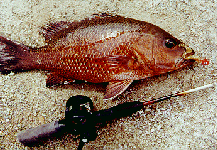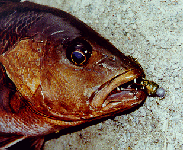



 Mangrove Jack
Mangrove Jack
Lutjanus Argentinumaculatus a.k.a. Siakap Merah, Kakap Merah, Jenahak Temerah. A rogue is an apt description of this fish. It is a powerful fish for its size and, with its aggressive character, it makes a great sport fish! The mangrove jack is normally found in the estuary area within depressions, around structure and snags, especially around the mangroves, hence its name. However, occasionally it can be found at the offshore reefs in deep waters. The mangrove jack averages between half a kilo to four kilos, four kilos being an exceptional size. The large jacks of over 2 kilos are normally found offshore. Generally anything over a kilo is considered a good size. It is good to eat and is a popular fish, farmed commercially at the local fish farms. It can be caught with dead baits like prawns, fish strips or squid. However, using live bait like prawns or small fish achieve greater success. It likes to sit within or around structure, waiting to ambush its prey. It will dart out, grab the prey and head straight back into its line cutting snags! Equipped with a nice set of teeth, very much like fangs, it can bite very well! The baits usually have to be placed in or very near the hang-out of the mangrove jack to get them to bite. When the mangrove jack hits the bait it is like an express train pulling the line into the snag territory! In other words, stout tackle should be used! So hang on to the rod and reel, or it might disappear into the water!  For lure casters, the mangrove jack is an exhilarating fish, purely because the chances of losing one's lure to this fish are pretty high. To get the fish to hit the lure, accurate casting is essential, right into snag territory or swim the lure within centimetres of the snag for the greatest success. Often the mangrove jack will hit the lure within a split second of splashdown or as the lure passes the most inhospitable fishing line snag ridden domain! All the mangrove jack does when it darts out (if it has to), is to grab the lure and swim back into the snags! All this happens within a split second. This sort of fishing isn't for the dreamy angler, but requires an alert angler, prepared to use skill to stop the mangrove jack from heading back into the snag. The use of brute force and tightened down drags are practised by some anglers, but often the adept use of the rod leverage can guide the mangrove jack out by a skilled angler.
For lure casters, the mangrove jack is an exhilarating fish, purely because the chances of losing one's lure to this fish are pretty high. To get the fish to hit the lure, accurate casting is essential, right into snag territory or swim the lure within centimetres of the snag for the greatest success. Often the mangrove jack will hit the lure within a split second of splashdown or as the lure passes the most inhospitable fishing line snag ridden domain! All the mangrove jack does when it darts out (if it has to), is to grab the lure and swim back into the snags! All this happens within a split second. This sort of fishing isn't for the dreamy angler, but requires an alert angler, prepared to use skill to stop the mangrove jack from heading back into the snag. The use of brute force and tightened down drags are practised by some anglers, but often the adept use of the rod leverage can guide the mangrove jack out by a skilled angler.Most lures that imitate bait fish like small rapala magnums or other plug type lures are good. But the most economical lures to use are the soft plastic lures, a fraction of the cost of the expensive plug lures. Soft plastic lures like the two or three inch shad minnow and the three to four inch grubs have been found to be very effective on the mangrove jack! Even though the mangrove jack has two impressive looking fangs hanging from the upper jaw, the use of wire leaders is not necessary. Just use some heavy mono leader of 10 kgs to ensure the line can resist the abrasion of the teeth. For the fly fishers looking for a real battle, an eight weight fly rod would be the minimum for the large mangrove jacks! The normal saltwater flies like clouser minnows, deceivers, poppers and sliders all work very effectively for the mangrove jack. Sight casting for the jacks can provide some thrills. The mangrove jack can often be seen feeding on small fish or prawns at the waters edge and a quick and accurate cast often results in hook up! |